Historical Conversations hosted its second event on 10 October 2017, with a discussion about medieval Scottish history.
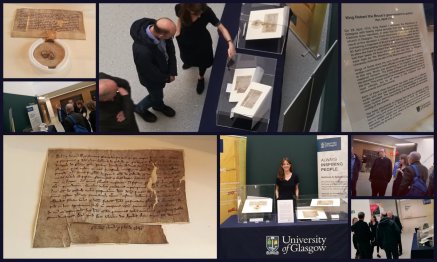 The speakers were Prof. Thomas Clancy (University of Glasgow), Prof. Stephen Driscoll (University of Glasgow), Prof. Dauvit Broun (University of Glasgow), and Prof. Steve Boardman (University of Edinburgh). The event included a display of three medieval documents from Glasgow University Archives.
The speakers were Prof. Thomas Clancy (University of Glasgow), Prof. Stephen Driscoll (University of Glasgow), Prof. Dauvit Broun (University of Glasgow), and Prof. Steve Boardman (University of Edinburgh). The event included a display of three medieval documents from Glasgow University Archives.
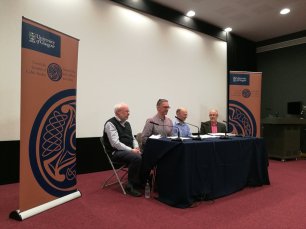 On 28 April 1315, King Robert I endowed the Blackfriars of Glasgow with twenty merks annually from his own income from Cadzow (now Hamilton), in order that the friars could light their church in Glasgow. This donation resulted in three separate documents: a ‘charter’ to the Blackfriars dated 28 April, and two ‘mandates’ dated 30 April commanding his chamberlain and his baillies of Cadzow to allow the friars to receive their twenty merks. All three documents have survived because they were kept by the Blackfriars. They are now part of the Blackhouse Charters collection, and are some of the oldest items held by Glasgow University Archives.
On 28 April 1315, King Robert I endowed the Blackfriars of Glasgow with twenty merks annually from his own income from Cadzow (now Hamilton), in order that the friars could light their church in Glasgow. This donation resulted in three separate documents: a ‘charter’ to the Blackfriars dated 28 April, and two ‘mandates’ dated 30 April commanding his chamberlain and his baillies of Cadzow to allow the friars to receive their twenty merks. All three documents have survived because they were kept by the Blackfriars. They are now part of the Blackhouse Charters collection, and are some of the oldest items held by Glasgow University Archives.
Charter of King Robert I to the Blackfriars (Ayr, 28 April 1315)
GUA, Blackhouse Charters, no. 3
In this charter, Robert I addresses his entire kingdom and notifies them that he has granted twenty merks annually to the Blackfriars. Only a fragment of Bruce’s seal remains attached to this sheet of parchment.
The scribe’s handwriting is an example of formal, decorative writing that could be used for charters like these. The scribe has incorporated stylistic features such as ‘ruching’ on some of the abbreviation marks, and he has used the thick side of his quill to make his horizontal suspension strokes look ‘bulging’. He has also decorated some of the capital letters (such as the first letter ‘R’ and an ‘I’ towards the end). (According to A. A. M. Duncan, this was ‘an ugly set hand’!) As he wrote, the scribe knew that the document, and the gift of twenty marks, were designed to endure forever (‘in perpetuity’).
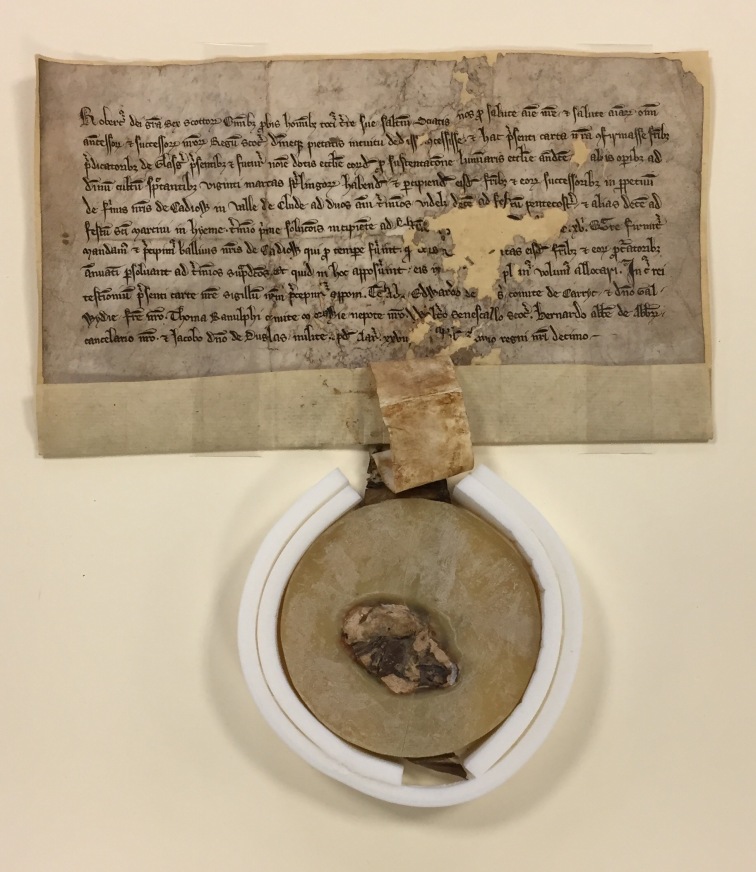
GUA, Blackhouse Charters, no. 3
With the permission of University of Glasgow Library Archives & Special Collections
Mandate of King Robert I to his chamberlain (Ayr, 30 April 1315)
GUA, Blackhouse Charters, no. 4
In this mandate, Robert I notifies his chamberlain of his gift to the Blackfriars of twenty marks annually from the king’s fermes of Cadzow. The chamberlain was an official in the king’s household who had responsibility for collecting the king’s ferms from the baillies. This document has lost Robert’s wax seal, which would originally have been stuck onto the strip at the bottom. The writing on this strip records the addressee (the chamberlain of Scotland).
- A. M. Duncan identified the scribe (‘Hand A’) as a royal scribe who wrote many documents for Robert I, including the surviving copy of the Declaration of Arbroath (held by the NRS). The scribe’s cursive handwriting contains the earliest known examples of a particular form of the letter ‘e’ that curls into a circle, a feature that became common in documents written in the second half of the fourteenth century and beyond. This is a significant feature because it allows us to date writing from this period, but previously it has only been known in Scottish documents from the 1350s. In this charter, we see a royal scribe occasionally (and probably unintentionally) using a feature in his handwriting which later became a regular and recognised part of the broader scribal repertoire in Scotland.
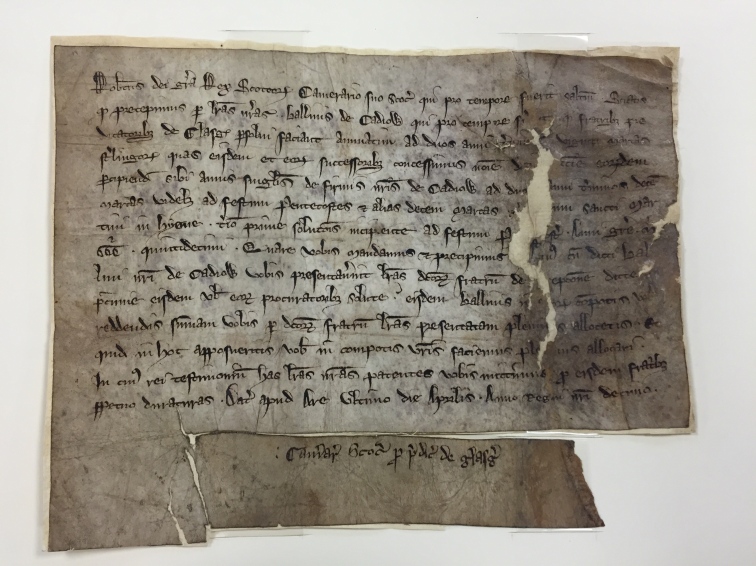
GUA, Blackhouse Charters, no. 4
With the permission of University of Glasgow Library Archives & Special Collections
Mandate of King Robert I to his baillies of Cadzow (Ayr, 30 April 1315)
GUA, Blackhouse Charters, no. 6
In this mandate, Robert I commands his baillies to pay the twenty marks annually to the Blackfriars of Glasgow from the king’s fermes of Cadzow.
This command was written on the same day as that addressed to the chamberlain, although seemingly by a different scribe. This document has also lost its wax seal, and the strip at the bottom contains a note of the addressee (the baillies of Cadzow). Like ‘Hand A’, this scribe also wrote in a cursive style with his letters more rounded and somewhat squashed looking, with lots of loops to allow him to write more quickly in a stylish way.
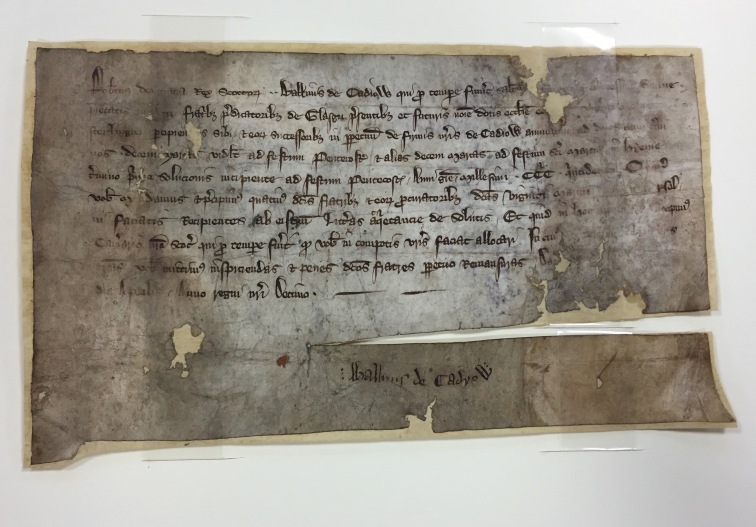
GUA, Blackhouse Charters, no. 6
With the permission of University of Glasgow Library Archives & Special Collections
Joanna Tucker @jocamerontucker
University of Glasgow

